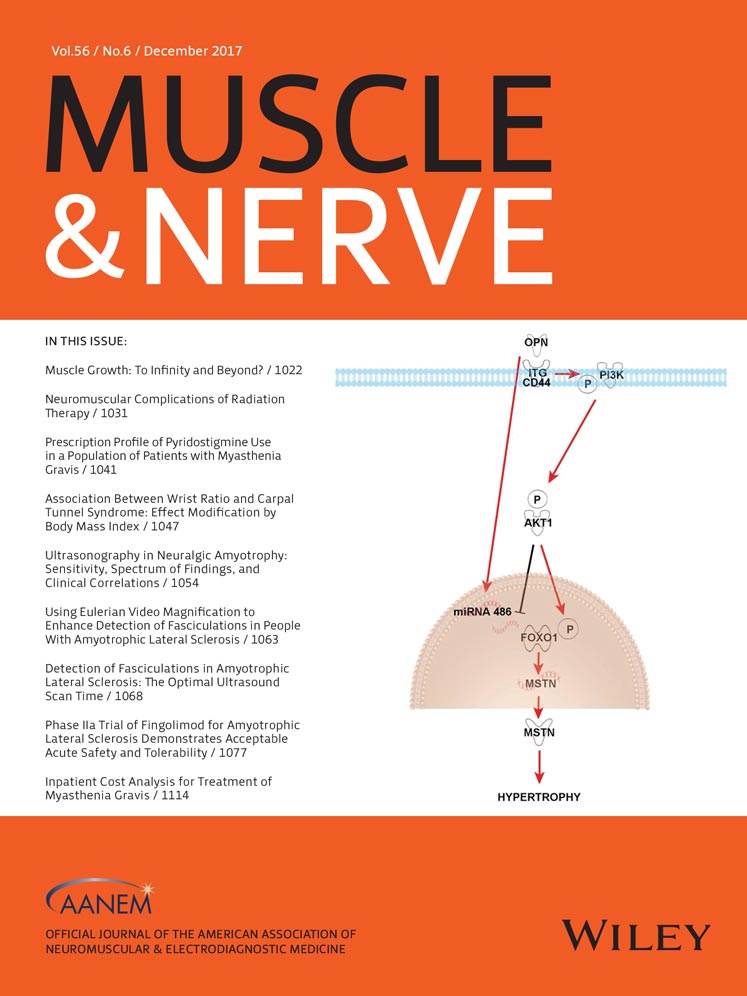Work-related carpal tunnel syndrome: What's important?
Corresponding Author
Gary M. Franklin MD, MPH
Department of Environmental and Occupational Health Sciences, 130 Nickerson Avenue, Suite 212, Seattle, Washington, 98109 USA
Department of Neurology, University of Washington, Seattle, Washington, USA
Department of Health Services, University of Washington, Seattle, Washington, USA
Washington State Department of Labor and Industries, Olympia, Washington, USA
Correspondence to: G.M. Franklin; e-mail: [email protected]Search for more papers by this authorZachary Gray BS, MPH
Washington State Department of Labor and Industries, Olympia, Washington, USA
Search for more papers by this authorCorresponding Author
Gary M. Franklin MD, MPH
Department of Environmental and Occupational Health Sciences, 130 Nickerson Avenue, Suite 212, Seattle, Washington, 98109 USA
Department of Neurology, University of Washington, Seattle, Washington, USA
Department of Health Services, University of Washington, Seattle, Washington, USA
Washington State Department of Labor and Industries, Olympia, Washington, USA
Correspondence to: G.M. Franklin; e-mail: [email protected]Search for more papers by this authorZachary Gray BS, MPH
Washington State Department of Labor and Industries, Olympia, Washington, USA
Search for more papers by this author
REFERENCES
- 1 Thiese MS, Merryweather A, Koric A, Ott U, Wood EM, Kapellusch J, et al. The association between wrist ratio and carpal tunnel syndrome: effect modification by body mass index. Muscle Nerve (to be published).
- 2 Harris-Adamson C, Eisen EA, Dale AM, Evanoff B, Hegmann KT, Thiese MS, et al. Personal and workplace psychosocial risk factors for carpal tunnel syndrome:a pooled study cohort. Occup Environ Med 2013; 70: 529–537.
- 3 Silverstein M, Silverstein B, Franklin GM. Evidence for work-related musculoskeletal disorders: a scientific counterargument. J Occup Environ Med 1996; 38: 1996.
- 4 Rempel D, Evanoff B, Amadio PC, de Krom M, Franklin G, Franzblau A, et al. Consensus criteria for the classification of carpal tunnel syndrome in epidemiologic studies. Am J Public Health 1998; 88: 1447–1451.
- 5 Harris I, Mulford J, Solomon M, van Gelder JM, Young J. Association between compensation status and outcome after surgery. JAMA 2005; 293: 1644–52.
- 6 Lane LB, Starecki M, Olson A, Kohn N. Carpal tunnel syndrome diagnosis and treatment: a survey of members of the American Society for Surgery of the Hand. J Hand Surg Am 2014; 39: 2181–2187.
- 7 Washington Department of Labor and Industries. Work-related carpal tunnel syndrome: diagnosis and treatment guideline. http://www.lni.wa.gov/ClaimsIns/Files/OMD/MedTreat/CarpalTunnel.pdf/. Accessed May 21, 2017.
- 8 Werner RA, Gell N, Franzblau A, Armstrong TJ. Prolonged median sensory latency as a predictor of future carpal tunnel syndrome. Muscle Nerve 2001; 24: 1462–1467.
- 9 Dale AM, Gardner BT, Buckner-Petty S, Strickland JR, Evanoff B. Postoffer pre-placement screening for carpal tunnel syndrome in newly hired manufacturing workers. J Occup Environ Med 2016; 58: 1212–1216.
- 10 Kapellusch JM, Gerr FE, Mallow EJ, Garg A, Harris-Adamson C, Bao SS, et al. Exposure–response relationships for the ACGIH threshold limit value for hand-activity level: results from a pooled data study of carpal tunnel syndrome. Scand J Work Environ Health 2014; 40: 610–620.
- 11 Harris-Adamson C, Eisen EA, Kapellusch J, Garg A, Hegmann KT, Thiese MS, et al. Biomechanical risk factors for carpal tunnel syndrome: a pooled study of 2474 workers. Occup Environ Med 2015; 72: 33–41.
- 12 Garg A, Kapellusch J, Hegmann K, Wertsch J, Merryweather A, Deckow-Schaefer G, et al. The strain index (SI) and threshold limit value (TLV) for hand activity level (HAL): risk of carpal tunnel syndrome (CTS) in a prospective study. Ergonomics 2012; 55: 396–414.
- 13 Johnson EW, Gatens T, Poindexter D, Bowers D. Wrist dimensions: correlation with median sensory latencies. Arch Phys Med Rehabil 1983; 64: 556–557.
- 14 Gordon C, Johnson EW, Gatens PF, Ashton JJ. Wrist ratio correlation with carpal tunnel syndrome in industry. Am J Phys Med Rehabil 1988; 67: 270–272.
- 15 Radecki P. A gender specific wrist ratio and the likelihood of a median nerve abnormality at the carpal tunnel. Am J Phys Med Rehabil 1994; 73: 157–162.
- 16 Nathan PA, Keniston RC. Carpal tunnel syndrome and its relation to general physical condition. Hand Clin 1993; 9: 253–261.
- 17 Chiotis K, Dimisianos N, Rigopoulou A, Chrysanthopoulou A, Chroni E. Role of anthropometric characteristics in idiopathic carpal tunnel syndrome. Arch Phys Med Rehabil 2013; 94: 737–744.
- 18 Farmer JE, Davis TR. Carpal tunnel syndrome: a case-control study evaluating its relationship with body mass index and hand and wrist measurements. J Hand Surg Eur 2008; 33: 445–448.
- 19 Melhorn JM, Talmadge JB, Ackerson WE, Hyman MH. AMA guides to the evaluation of disease and injury causation, 2nd ed. OEM Press: Beverly Farms, MA; 2013.
- 20 Andersen JH, Thomsen JF, Overgaard E, Lassen CF, Brandt LP, Vilstrup I, et al. Computer use and carpal tunnel syndrome: a 1-year follow-up study. JAMA 2003; 289: 2963–2969.
- 21 Eleftheriou A, Rachiotis G, Varitimidis SE, Koutis C, Malizos KN, Hadjichristodoulou C. Cumulative keyboard strokes: a possible risk factor for carpal tunnel syndrome. J Occup Med Toxicol 2012; 7: 16.
- 22 Guyton GP. A brief history of workers' compensation. Iowa Orthop J 1999; 19: 106–110.




